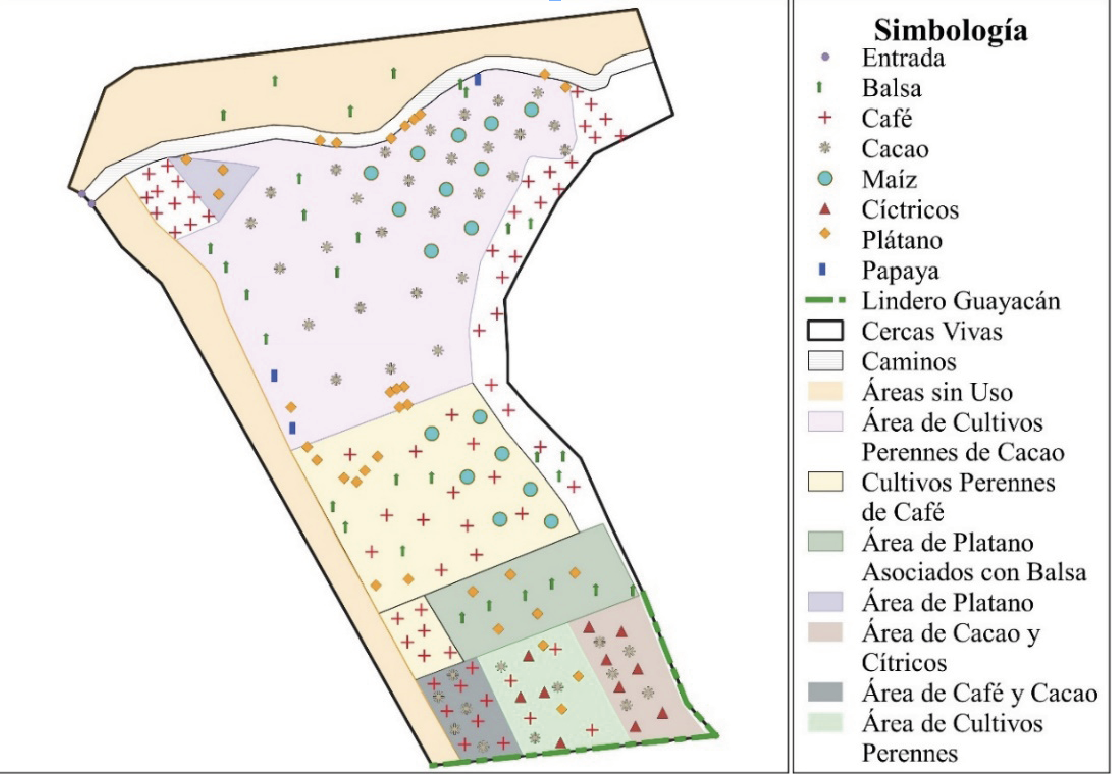Socioeconomic diagnosis of agroforestry systems in the San Francisco area of the El Anegado parish
DOI:
https://doi.org/10.54753/blc.v14i1.2037Keywords:
Agroforestry, community, family, conservation, species, ruralAbstract
Agroforestry systems constitute an alternative for rural development, so in this investigation a socioeconomic diagnosis was made; the strengths, opportunities, weaknesses and threats of the main aspects were analyzed in order to redesign the agroforestry systems, considering the knowledge and needs of the producer and proposes the redesign of the SAF as a contribution to the increase, improvement and diversification of the production of the farms. Palmital and La Fortuna, in the San Francisco precinct of El Anegado parish, province of Manabí. The results indicated that both farms present differences regarding their structure and diversification. The family nucleus is made up of seven members, the parents, three children and two grandchildren; ages range from 18 to 64 years. The largest use of land in El Palmital is the planted area 74,23% (1,80 ha), while in La Fortuna the non-agricultural area predominated 55,88% (0,95 ha). Among the proposals for adjustments for the redesign of the farms under study are: establishment of a drip irrigation system for perennial crops, use and marketing of non-timber forest products, replanting and protection of seedlings of woody species in the live fences, namely Inga spectabilis (Vahl) Will. and Handroanthus chrysanthus (Jacq.) SO Grose, pruning to reduce excess shade, phytosanitary thinning, diversification of perennial crops, terraces on high slopes, to control water erosion, improve infiltration and increase the availability of soil water.References
Becerra, L., Arellano G., R., y Pineda, C. N. (2006). Diagnóstico agrosocioeconómico de las fincas cafetaleras de la microcuenca del río Monaicito, estado Trujillo-Venezuela. Revista Geografica Venezolana [en línea], 47(1), 11–28. Disponible en <http://www.redalyc.org/articulo.oa?id=347730363002%0A>
Checa, X., Ramos, R., y Grijalva, J. (2010). Caracterización de Sistemas Agroforestales (SAF’s) en la Sub-Región Sierra Centro del Ecuador. XII Congreso Ecuatoriano de La Ciencia Del Suelo [en línea], 1–10. Disponible en <https://nanopdf.com/download/caracterizacion-de-sistemas-agroforestales-safs-en-la-sub-region-sierra_pdf>
Dago, Y. (2019). Acciones para el manejo de especies bovinas con técnicas agroforestales en la unidad de producción “El Vaquerito.” Revista Cubana de Ciencias Forestales [en línea], 14(2), 162–170. Disponible en <http://scielo.sld.cu/pdf/cfp/v7n2/2310-3469-cfp-7-02-162.pdf>
Farfán, F. (2013). Establecimiento de sistemas agroforestales con café. En Federación Nacional de Cafeteros de Colombia, Manual del cafetero colombiano: Investigación y tecnología para la sostenibilidad de la caficultura (Vol. 2, pp. 44–63). Cenicafé. <https://biblioteca.cenicafe.org/jspui/bitstream/10778/4330/1/cenbook-0026_18.pdf>
Farfán, F. (2014). Mantenimiento del componente arbóreo en sistemas agroforestales con café (Gerencia técnica/ Programa de Investigación Científica Fondo Nacional del Café No. 440). Colombia: Cenicafé. <https://biblioteca.cenicafe.org/bitstream/10778/486/1/avt0440.pdf>
Filho, V., y De Melo, E. (2014). Agroforestería sostenible en la Amazonia ecuatoriana (Serie técnica. Informe técnico/CATIE No. 398). Turrialba, Costa Rica: CATIE <https://www.researchgate.net/publication/271203962_Agroforesteria_Sostenible_en_la_Amazonia_Ecuatoriana>
García, L. (1999). Diagnóstico Agroecológico de Sistemas Agrícolas. Centro de Estudios de Agricultura Sostenible. Universidad Agraria de la Habana. Cuba.
Garro Chacón, L. E. (2020). Diseño de un sistema agroforestal en fincas ecológicas de café para la conectividad de dos áreas protegidas en providencia de copey, costa rica [Trabajo de grado, Instituto Tecnológico de Costa Rica]. <https://repositoriotec.tec.ac.cr/bitstream/handle/2238/12399/TFG_Luis_Garro_Chacon.pdf?sequence=1&isAllowed=y>
Gobierno Autónomo Descentralizado [GAD] Parroquial de El Anegado. (2019). Plan de Desarrollo y Ordenamiento Territorial 2019-2023. <https://gadelanegado.gob.ec/manabi/wpcontent/uploads/2021/04/PDyOT_El_Anegado_2020-1.pdf>
Gutiérrez, B., y Fierro, L. H. (2006). Diagnóstico y Diseño Agroforestal Participativo: Metodología. Estructuración de fincas modales en sistemas de producción agroforestal y silvopastoril en núcleos forestales vinculados a la cadena forestal, Colombia <https://repository.agrosavia.co/bitstream/handle/20.500.12324/17384/41810_44029.pdf?sequence=1&isAllowed=y>
Jiménez González, A., Saltos Arteaga, E. E., Ramos Rodríguez, M. P., Cantos Cevallos, C. G., y Tapia Zúñiga, M. V. (2018). Aprovechamiento y potencialidades de uso de Phytelephas aequatorialis Spruce como producto forestal no maderable. Revista Cubana de Ciencias Forestales [en línea], 6(3), 311–326. Disponible en <http://cfores.upr.edu.cu/index.php/cfores/article/view/349>
Lanz, O., y Granado, Y. (2009). Diagnóstico agrosocioeconómico del sector cacao (Theobroma cacao L.) en Yaguaraparo, Municipio Cajigal, estado Sucre, Venezuela. Revista Cientifica UDO Agricola [en línea], 9(2), 425–435. Disponible en <https://dialnet.unirioja.es/servlet/articulo?codigo=3308578>
López Benítez, F. L. (2014). Teoría de Diseño y Diagnóstico Agroforestal (D&D). CATIE. <https://docplayer.es/12814283-Tema-4-teoria-de-diseno-y-diagnostico-agroforestal-d-d-francisco-leonel-lopez-benitez-catedratico.html>
Mata, D., Rivero, M., y Segovia, E. (2018). Sistemas agroforestales con cultivo de cacao fino de aroma: entorno socio-económico y productivo. Revista Cubana de Ciencias Forestales [en línea], 6(1), 103–115. Disponible en <http://cfores.upr.edu.cu/index.php/cfores/article/view/280>
Mendieta, M., & Rocha, L. (2007). Sistemas Agroforestales. Universidad Nacional Agraria. <https://repositorio.una.edu.ni/2443/>
Narvaez, A. U., Cruz, A., y Sangerman, D. M. (2020). Servicios ambientales: sistema agroforestal tradicional con plantas de maguey pulquero en la Altiplanicie, Hidalgo. Revista Mexicana de Ciencias Agrícolas [en línea], 11(8), 1957–1969. Disponible en <https://doi.org/10.29312/remexca.v11i8.2750>
Nello, T., Fonseca, F., Raes, L., Sanchún, A., Saborío, J., y Chacón, O. (2018). Sistemas agroforestales de cacao. Guía técnica para la restauración en El Salvador, 4. San José, Costa Rica: UICN-ORMACC. xii, p. 24. <https://infoflr.org/sites/default/files/2020-04/guia_tecnica_para_la_restauracion_en_el_salvador__sistemas_agroforestales_de_cacao.pdf>
Oficina Nacional Forestal (ONF). 2013. Guía Técnica SAF para la implementación de Sistemas Agroforestales (SAF) con árboles forestales maderables.
QGIS.ORG, (2022). QGIS Geographic Information System. QGIS Association. <http://www.qgis.org>
Ramos, P., Del Amo, R. y Arévalo, R. (1996). “Diversidad y tipos agroecosistemas: Consideraciones para diseño”. En Trujillo, F., De León, G., Calderón, A. y Torres, L. (Comp.), Ecología aplicada a la agricultura, temas selectos de México. Unidad Xochimilco: Editorial Universidad Autónoma Metropolitana. Pp. 119-125.
Segura, M., Zuñiga, G., Araya, J., y Villegas, O. (2007). Planificación Agroforestal de la Finca. Proyecto “Promoviendo mercados sostenibles para MiPyMEs y productores rurales en Costa Rica (PROMES). <http://usi.earth.ac.cr/glas/sp/DocTecnicos/Promes/PimientaM4.pdf>
Solarte, Z. Montes, C. Paz, J. (2019). Caracterización y diagnóstico de los sistemas productivos en la vereda San Roque, Morales – Cauca. Revista Biotecnología en el Sector Agropecuario y Agroindustrial [en línea], 17(2), 24-35. Disponible en http://dx.doi.org/10.18684/bsaa.v17n2.1250>
Somarriba, E. (2002). Estimación visual de la sombra en cacaotales y cafetales. Agroforestería En Las Américas [en línea], 9(35), 86–94. Disponible en <https://repositorio.catie.ac.cr/bitstream/handle/11554/6237/Estimacion_visual_de_la_sombra.pdf?sequence=1&isAllowed=y>
Somarriba, E.; y Calvo, G. (2001). Planificación agroforestal de fincas. Manual preparado para el curso de Maestría del CATIE. Turrialba, Costa Rica. 80 p.
Somarriba, E. (2009). Planificación Agroforestal de Fincas (PAF). Centro Agronómico Tropical de Investigación y Enseñanza, CATIE. <https://simas.org.ni/media/PAF_Libro_Impreso.pdf>
Soto, L., Jimenez, G., y Lener, T. (2008). Diseño de Sistemas Agroforestales para la Producción y la Conservación: Experiencia y Tradición en Chiapas (Primera Ed). El Colegio de la Frontera Sur, ECOSUR. <https://www.researchgate.net/publication/284304882_Diseno_de_Sistemas_Agroforestales_para_la_Produccion_y_la_Conservacion_Experiencia_y_Tradicion_en_Chiapas>
Urbina, S. (2019). Evaluación de prácticas agroecológicas implementadas en seis fincas de la microcuenca Río El Gallo Municipio de San Pedro del Norte, Departamento Chinandega [Trabajo de grado, Universidad Nacional Agraria]. <http://repositorio.bibliotecaorton.catie.ac.cr/handle/11554/8048>
Valencia, R., Montúfar, R., Navarrete, H., y Balslev, H. (2013). Capítulo 13. Phytelephas aequatorialis. In Palmas Ecuatorianas: biología y uso sostenible (Primera Ed, pp. 186–201). <https://www.researchgate.net/publication/259823093_Capitulo_13_Tagua_Phytelephas_aequatorialis>
Vega Játiva, M. M. (2005). Planificación Agroforestal participativa para el enriquecimiento de fincas cacaoteras orgánicas con especies leñosas perennes útiles, Alto Beni, Bolivia. [Tesis de maestría, Centro Agronómico Tropical de Investigación y Enseñanza (CATIE)]. <http://www.sidalc.net/repdoc/A0659e/A0659e.pdf>
Viñedos, y Olivar. (2018). Cultivos Permanentes (Ficha técnica de biodiversidad). Fundación Global Nature Foods & Biodiversity.

Published
How to Cite
Issue
Section
License
Copyright (c) 2024 Bosques Latitud Cero

This work is licensed under a Creative Commons Attribution-NonCommercial-ShareAlike 4.0 International License.
This work is published under the Creative Commons Attribution-NonCommercial-ShareAlike 4.0 International (CC BY-NC-SA 4.0) license. This means that users may copy, distribute, and adapt the content, provided that proper credit is given to the authors and the journal. Commercial use of the material is not permitted. Additionally, any derivative work must be distributed under the same license. This license ensures open access to knowledge, promoting the dissemination and reuse of published works for non-commercial purposes, respecting authorship, and ensuring the free circulation of content under fair terms.




























